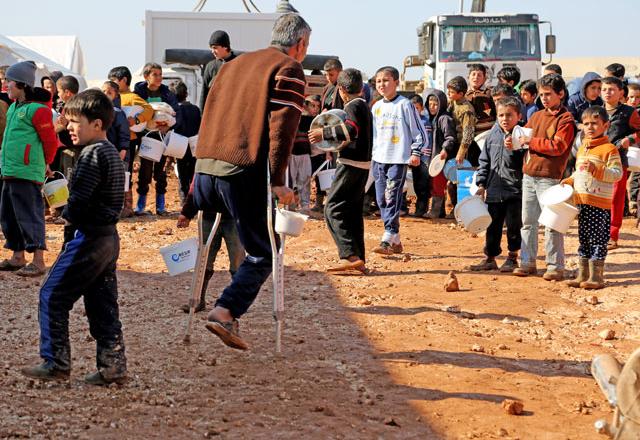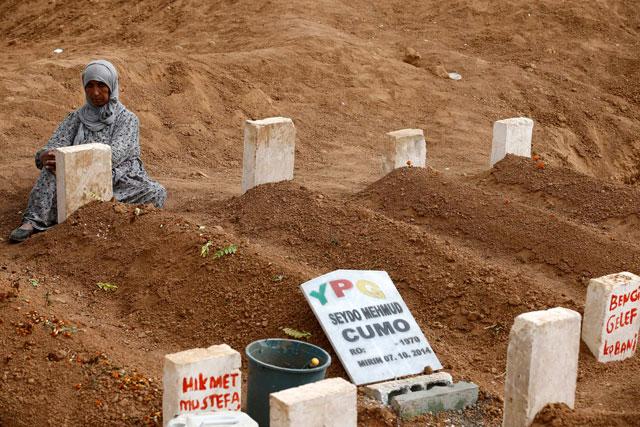You are here
Syria rebels await action from Trump on safe zones, Damascus silent
By Reuters - Jan 26,2017 - Last updated at Jan 26,2017

A man with the help of crutches leaves after getting meal at a tent city built up for the families coming from Aleppo, in northern Idlib, Syria, on January 22 (Anadolu Agency photo)
BEIRUT — Syrian rebels urged President Donald Trump to fulfil a pledge to create safe zones in their country, but analysts doubted he would proceed with a step that could drag Washington deeper into war, hasten Syria's fragmentation and risk conflict with Russia.
Trump told ABC News on Wednesday he "will absolutely do safe zones in Syria" for refugees fleeing violence and that Europe had made a mistake by admitting millions of refugees from Syria.
President Bashar Al Assad's opponents have long demanded safe zones to protect civilians who have fled government air strikes and bombardment of rebel-held areas.
But reflecting uncertainties about the announcement, representatives of the insurgents voiced only cautious optimism.
"We've seen no result on the ground from [US] statements that were made six years ago. So therefore we await action before anything else," said Fares Al-Bayoush, a rebel commander in northwestern Syria.
Qatar, which backs the rebels, welcomed Trump's comments and "emphasised the need to provide safe havens in Syria and to impose no-fly zones to ensure the safety of civilians".
There was no immediate word from Damascus, but it is sure to oppose such a move as Assad has vowed to regain control of all Syria. Iran, which backs militias in Syria including Lebanon's Hizbollah, would also oppose any US intervention.
Russia said it had not been consulted on Trump's plan, warning that it should not "exacerbate the situation with refugees" and Washington should weigh up "all the consequences".
Major policy shift
The creation of safe zones would mark a major shift in US policy. Former US president Barack Obama resisted an idea that would require a commitment to defend such areas from the Syrian government or its foreign allies, including Russia.
Trump appears to see safe zones as a way to stem the tide of refugees which he sees as a possible threat to US security.
But there are no obvious answers as to how the United States would avoid the problems that have prevented it establishing safe zones in Syria before, including the complication of policing such an area in a war zone dotted with armed groups.
“At this stage this is very much in the realm of political manoeuvring,” said Yezid Sayigh, a senior fellow and Syria expert at the Carnegie Middle East Centre in Beirut. “I don’t think it is signalling imminent US action.”
Trump could order the State Department and Pentagon to produce a plan that would also create “safe areas” in countries surrounding Syria where millions of refugees already live.
The Syrian government hopes Trump will end US support for the rebels fighting Assad and refocus US policy solely on fighting Daesh, perhaps in cooperation with Russia.
Trump has indicated he will do both.
Almost six years of war has turned Syria into a patchwork of areas, some controlled by Assad, some by rebel groups and others by Kurdish militia or Daesh militants.
Previous discussion of safe zones in Syria has focused on rebel-held areas in the northwest stretching from Idlib province to the Euphrates River. Areas in the southwest at the border with Jordan have also been seen as a possibility.
But the complications have grown since the Syrian opposition first called for safe zones, including the deployment of Russia’s air force to Syria.
Defending a safe zone from attack by the Syrian government or its Russian and Iranian-backed militia allies would inevitably lead to an escalation, which is one of the reasons Obama had avoided this path in the first place, Sayigh said.
Another big challenge would be how to police the area to maintain its neutral status as a safe zone, he added.
Do safe zones work?
While much of Trump’s Syria policy remains unclear, Syrian Kurds, who have generally avoided conflict with Assad, look set to remain central to US strategy.
The Syrian Kurdish YPG militia controls swathes of northeast Syria, where conflict with the government is rare and the US air force mounts regular air strikes against Daesh targets.
Syrian Kurdish autonomy in northern Syria alarms Turkey, which fears it could increase separatist sentiment among its Kurdish minority. Kurdish groups already govern northern Iraq, where the establishment of a no-fly zone in 1991 helped them on their way to autonomy from Baghdad.
The YPG has links to the Kurdistan Workers Party (PKK), a designated terrorist groups in Turkey.
Growing Kurdish influence in northern Syria largely explains why Turkey launched a major incursion into Syria last year, helping insurgents from the Free Syrian Army drive both Daesh and Kurdish militia away from the border.
The operation dubbed “Euphrates Shield” has created what Turkish officials call a safe zone that is 100km long. This week, a new Turkish-trained Syrian police force deployed in the town of Jarablus in that strip of territory.
Turkey, which hosts 2.8 million Syrian refugees, has long advocated safe zones in Syria.
But underlining the caution with which foreign governments are viewing Trump’s comments, Turkey said it was waiting to see the outcome of a “study” requested by Trump.
Aid agencies in the region are concerned.
Karl Schembri, Regional Media Adviser in the Middle East for the Norwegian Refugee Council, said that from the group’s experience, “we know that militarily enforced ‘safe zones’ rarely work and can actually put civilians at more risk”.
Related Articles
The Obama administration is boxed in by its promise to limit US military engagement against Islamic State (IS) group extremists, making it tough to agree to Turkey's condition for joining the fight in neighbouring Syria.
Turkish President Recep Tayyip Erdogan has said his country opposes the idea of a Kurdish-controlled autonomous government in northern Syria.
ISTANBUL — Turkish President Recep Tayyip Erdogan said Tuesday that Ankara would set up a "security zone" in northern Syria suggested by US

















